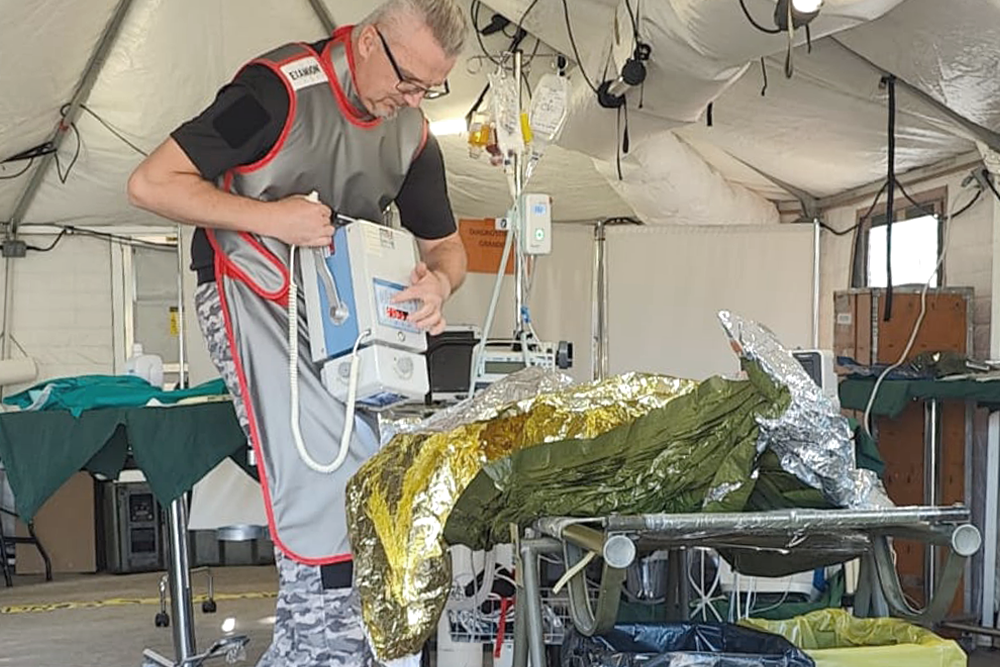Mobile and portable X-ray - bringing the X-ray examination to the patient
What if a patient is unable to access routine X-ray care at a clinic or practice? Because their own state of health does not permit transportation, external circumstances do not allow it or because the distance to the nearest clinic or practice is too far? Mobile and portable X-ray solutions exist for these and other application scenarios.
Mobile X-rays on patients
The state of health of frail patients can deteriorate simply because of transportation to an X-ray examination or the changed environment in hospital. This usually requires more care and medication. Sometimes an inpatient stay is even necessary.
Mobile X-ray machines enable nursing home residents, for example, to have the necessary examinations - without causing such consequences. Residents of homeless shelters and asylum seekers can also benefit from the use of mobile X-ray machines.1 Studies report these specific benefits:1, 2, 3
- avoidance of hospitalization and patient transport
- avoidance of worsening of illness due to transportation or hospitalization
- reduced waiting times
- higher number of patients examined, more certainty with suspected diagnoses
- greater cost-effectiveness
- greater satisfaction among patients and healthcare staff
Stationary X-ray systems can also be mobilized to ensure medical care in crisis areas, after environmental disasters or on the high seas. Space-saving, flexible X-ray solutions such as swivel bracket systems are particularly suitable for converting vehicles and containers into mobile X-ray units.
Mobile and portable X-ray solutions - not just for emergency care
Mobile and portable X-ray solutions are also used outside of emergency care, for example when the catchment area of a radiology practice cannot be economically viable due to sparse population. Especially in combination with the ongoing expansion of mobile phone networks, mobile digital X-ray solutions can contribute to adequate healthcare, as not only remote evaluation and consultation, but also the exchange between doctors at different locations is possible. In a survey, American radiologists emphasized not only the spatial flexibility but also the temporal flexibility of 'teleradiology examinations', in which the digital X-ray examination and reporting do not take place at the same location.4
Systematic tuberculosis screening in remote areas
The WHO recommends systematic tuberculosis (TB) screening in countries with high TB prevalence.5 However, poor or particularly vulnerable populations often do not have access to routine examinations at health facilities. In many countries, systematic screening (active case finding) is therefore carried out in remote or isolated areas using portable or mobile X-ray machines, for example on Daru Island, a western province of Papua New Guinea,6 or in hard-to-reach areas in the Niger Delta of Nigeria.7
Using a portable digital X-ray machine on Daru Island, a high TB detection rate was achieved, which at 853 per 100,000 screening participants was significantly higher than the estimated national incidence in Papua New Guinea (432 per 100,000 inhabitants).6 In Nigeria, a portable digital X-ray machine was used to identify 1,140 suspected TB cases among 8,230 participants, among whom the prevalence was ultimately 8.6%.7
Overall, these examples show the extensive field of application of mobile and portable X-ray examinations outside of emergency medicine and as a supplement to routine care. The requirements to be met with regard to radiation protection depend, among other things, on the place of use (fixed or non-fixed), the environmental conditions and the planned number of X-ray exposures.
Sources
1Andersen PAB, et al. How to set up a mobile X-ray unit in the community - Implementation initiatives for patient-centered care. Radiography (Lond) 2023, 29 Suppl 1, S148-s51.
2Kjelle E, et al. Mobile X-ray services in care homes: a systematic review of outcomes for residents and the community. BMC Health Serv Res 2017, 17, 231.
3Toppenberg MD, et al. Mobile X-ray outside the hospital: a scoping review. BMC Health Serv Res 2020, 20, 767.
4Rosenkrantz AB, et al. The Current State of Teleradiology Across the United States: A National Survey of Radiologists' Habits, Attitudes, and Perceptions on Teleradiology Practice. J Am Coll Radiol 2019, 16, 1677-87.
5WHO Guidelines Approved by the Guidelines Review Committee. In WHO consolidated guidelines on tuberculosis: Module 2: Screening - Systematic screening for tuberculosis disease; World Health Organization: Geneva, 2021.
6Dakulala P, et al. Evaluation of a population-based systematic screening initiative for tuberculosis on Daru Island, Western Province, Papua New Guinea. BMC Public Health 2024, 24, 959.
7Odume B, et al. Portable digital X-ray device for TB pre-diagnosis screening in rural communities in Nigeria. Public Health Action 2022, 12, 85-9.
